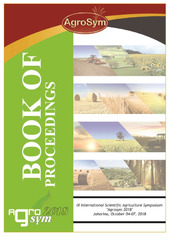| dc.creator | Bugarski, Dušanka | |
| dc.creator | Gvozdanović-Varga, Jelica | |
| dc.creator | Vasić, Mirjana | |
| dc.creator | Červenski, Janko | |
| dc.creator | Vlajić, Slobodan | |
| dc.date.accessioned | 2023-10-10T07:36:41Z | |
| dc.date.available | 2023-10-10T07:36:41Z | |
| dc.date.issued | 2018 | |
| dc.identifier.isbn | 978-99976-718-8-2 | |
| dc.identifier.uri | http://fiver.ifvcns.rs/handle/123456789/3789 | |
| dc.description.abstract | Distribution of oyster mushroom production worldwide is based on its cultivation on available
and low-priced substrates prepared using residues of cellulose materials from agricultural
production. It is also based on its nutritive value and content of medically active matters that
favourably affect the human organism, as well as the specific taste, which offers wide
possibilities in cooking. Forms of oyster mushroom differ by colour, size and shape of the
cap, length and width of stems, taste, as well as the physiological requirements during
cultivation on different substrates in various climate conditions. Three isolated and
determined strains of oyster mushroom (Pleurotus ostreatus) were studied - NS 77, NS 355
and NS 244. They were grown on residues of agricultural production most frequent on the
territory of Vojvodina, such as wheat and soybean stems, and stalks of maize and sunflower,
as individual substrates and in combinations with wheat straw. Variability was recorded
among strains in most important morphological traits. The study monitored the ratios of cap
weight (CW) and stem weight (SW), cap length (CL), cap width (CWi), stem length (SL) and
stem width (SWi), as well as the number of mushrooms per bunch (NM). The monitored
morphological traits have been expressed differently most of the time, depending on the
strain, while in some cases the substrate was the determining factor. The number of fruiting
bodies in strain NS 244 therefore varied in range 4.2-5.5, depending on the substrate. Strain
NS 77 ranged from 7.4 to 11.2, while strain NS 355 ranged from 8.6 to 10.7. However, the
highest values of cap weight of all three strains were recorded on maize stalk substrate. | sr |
| dc.language.iso | en | sr |
| dc.publisher | East Sarajevo : University of East Sarajevo, Faculty of Agriculture | sr |
| dc.rights | openAccess | sr |
| dc.rights.uri | https://creativecommons.org/licenses/by/4.0/ | |
| dc.source | Book of Proceedings, 9th International Scientific Agriculture Symposium "Agrosym 2018", 4-7 October 2018, Jahorina | sr |
| dc.subject | oyster mushroom | sr |
| dc.subject | morphological traits | sr |
| dc.subject | substrates | sr |
| dc.title | Morphological differences among strains of oyster mushroom grown on different substrates | sr |
| dc.type | conferenceObject | sr |
| dc.rights.license | BY | sr |
| dc.citation.epage | 624 | |
| dc.citation.spage | 618 | |
| dc.identifier.fulltext | http://fiver.ifvcns.rs/bitstream/id/9622/bitstream_9622.pdf | |
| dc.identifier.rcub | https://hdl.handle.net/21.15107/rcub_fiver_3789 | |
| dc.type.version | publishedVersion | sr |


